A task flow diagram is essential for keeping the thought process consistent for the entirety of a project. Following task flows can ensure users that the procedure of accomplishing a workflow goes as smoothly as possible. Businesses can prevent hindrances or anomalies by following the task flow diagram as a foundation for a guide.
But before you start formulating a task flow diagram to follow, it's essential that you first understand the crucial components for maximum efficiency. Spotting potential issues and delays early on can minimize risks while increasing output by a large degree.
Our team at Aloa utilizes task flow diagrams to ensure all projects are met in an orderly fashion. We understand that startups need strict regulations to ensure each step is carefully managed, as the tiniest error can lead to long-term consequences. As such, we empower our clients to know that each partnership is treated with careful precision.
In this blog post, we shall dive into how startups can strategically utilize a task flow diagram to optimize the work output and set themselves up for a successful 2024.
Let's start!
What is a Task Flow Diagram?
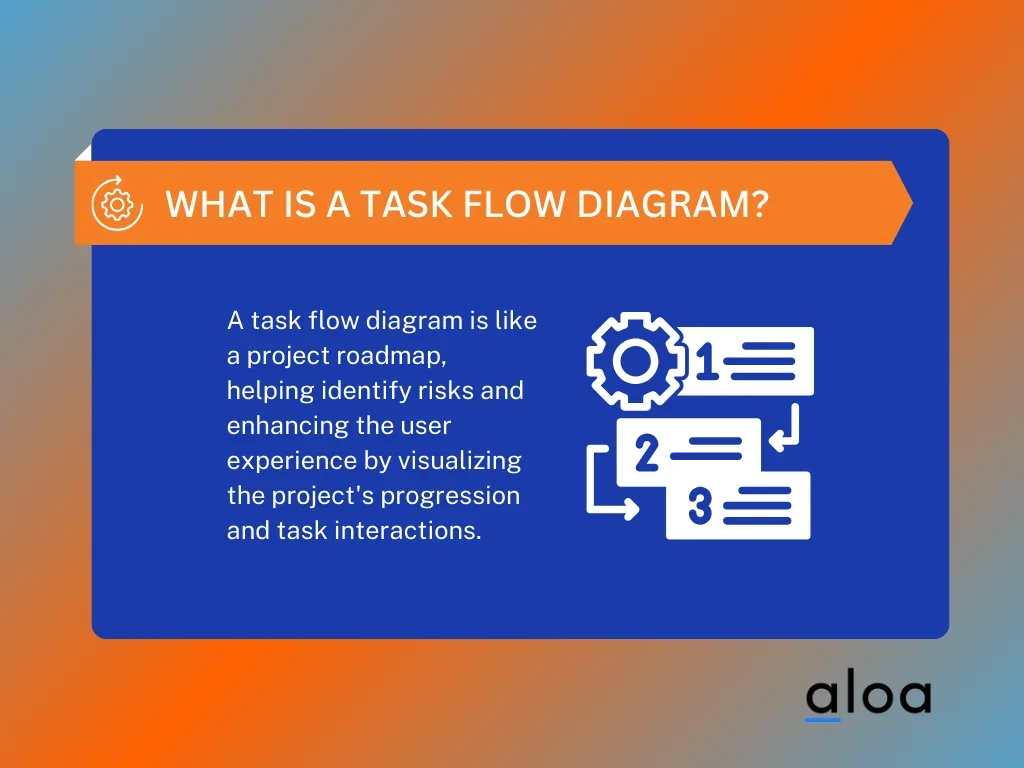
A task flow diagram is a visual representation of the various steps needed to successfully complete a project. Consider the diagram as a project roadmap that users can use to easily spot potential risks or delays in a project's formation while improving the overall user experience.
As the name suggests, a task flow diagram ensures the smoothness of the "flow" of a project. Analyzing how each task moves from one area to another while also supplementing each component in the assignment is a great way to visualize the overall project more clearly.
How to Make a Task Flow Diagram?
Planning and creating a task flow diagram requires essential steps to ensure that all crucial pieces fit the project plan concurrently. Here are the important steps to making the most optimal task flow diagram for your business:
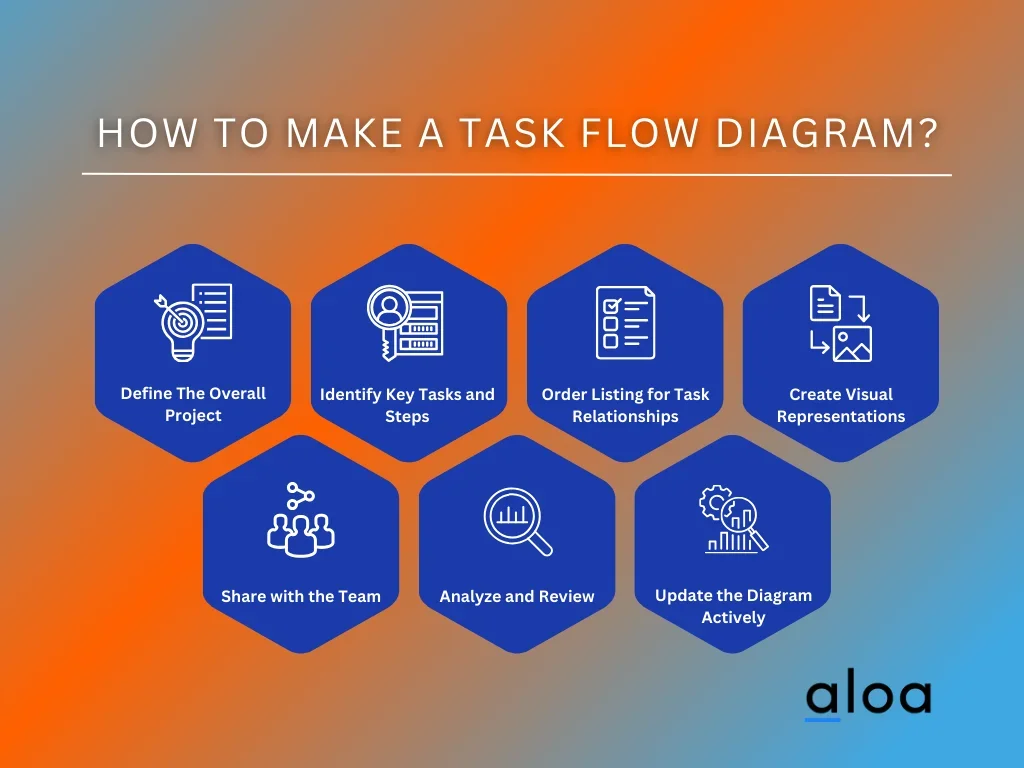
Step 1: Define The Overall Project
The main benefit of a task flow diagram is that it keeps each assignment consistently complimenting each component to maximize both the potential and the efficiency of the workflow. Understanding these key components helps define the overall project more clearly during the planning phase of the diagram.
Start the process by formulating a clear workflow goal you want to represent in the process flow diagram. Having a target goal, objective, quality, and deadline for each of the tasks can help determine which tasks take precedence over others.
Step 2: Identify Key Tasks and Steps
Once all the necessary information is set, it's time to break down the overall project plan into key actions or steps. Formulate an extensive list of each project and the requirements needed to ensure that the particular task can be considered complete.
It's crucial that you have a clear, specific goal for each task before moving on to the next step of the task flow diagram to prevent hindrance or unnecessary backtracking. Some tasks can also be combined into a larger overall structure to ensure optimal workflow efficiency.
Step 3: Order Listing for Task Relationships
As the name suggests, task flow diagrams are formulated to create a consistent flow that users can utilize to easily follow through the entire project plan. Analyze how each task of a project complements one another and start determining which assignments depend on the completion of another task.
Creating an order list that is simple to follow can ensure that any lacking components on a project can be addressed as soon as possible. Making a chronological listing of the tasks ensures that each step is easier to manage.
Step 4: Create Visual Representations
Various flowchart designs or diagramming tools can aid users in creating visual representations using easy-to-follow symbols, shapes, and lines. These visual representations can help an entire team to determine if the task has strong dependencies on the completion of other assignments or can also show various decision points that an organization can use before moving on.
Placing arrows or other guiding marks for each task action can help determine its continuing flow when completed. Guidelines can also be used to determine which projects require multiple completed assignments before progressing to the following sequence.
It's critical that the choice of visual representations is easy to understand and follow to ensure that every team member can be guided responsibly to each essential procedure. If possible, avoid creating multiple complex color choices or unorthodox symbols to ensure clarity in reading a task flow diagram. Consider the simplicity of a kanban board when creating the visual queues.
Step 5: Share with the Team
Businesses will need to appropriately share the information about each task with their team to ensure that each assignment's importance is addressed. Allow your team members to chime in, place their thoughts on the overall task flow diagram, and listen to their insights on how it can be improved.
Target goals are the most essential factor to discuss with team members when it comes to ensuring the task flow moves as smoothly as possible. Any limitations or hindrances should be addressed early to prevent the complete stalling of a project.
Step 6: Analyze and Review
Good project plans are complete with a thorough analysis of each component. Review each step in the task flow diagram and ensure that all essential tasks, dependencies, and potential bottlenecks are accounted for in the workflow.
Some diagrams might require testing before making proper decisions, so ensure that you allot some time for potential issues and delays to minimize missing deadlines.
Step 7: Actively Address and Update the Diagram
Once the task flow diagram is set into motion, it's vital that you actively address and update any movement or progress toward each task. Any member involved in the overall project can send notifications if they have completed their assignments for better efficiency.
Better integration of communication and project management tools can allow for a higher degree of active monitoring toward achieving the milestones set for each project.
Best Practices in Creating a Task Flow Diagram
Every business has its respective task flow diagram designs that can differ from one another. However, there are some crucial practices you can follow to help maximize the potential of your process flow diagrams. Here are some of the best practices to be mindful of:
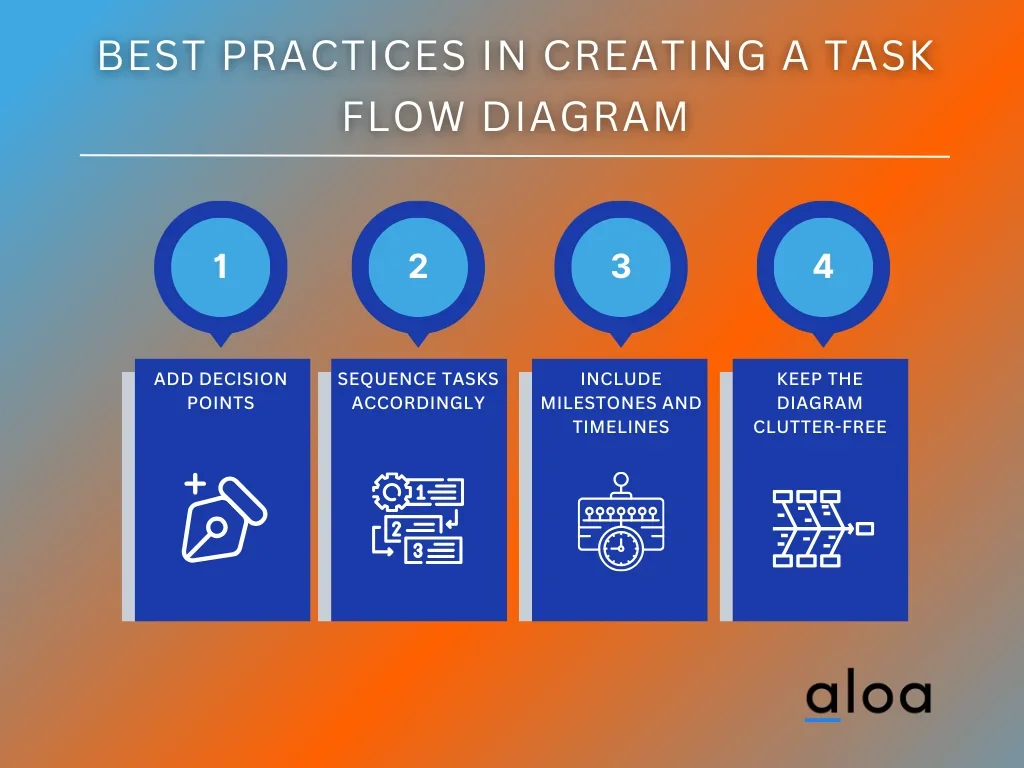
Add Decision Points
Not all projects will flow as smoothly regardless of how well-built a task flow diagram is. It's essential that there are open decision points for crucial parts of the project to ensure that there are options available should the direction shift to a different perspective.
Different paths or options can be labeled with a different shape, like a diamond, to indicate that an agreement must be made before continuing with a crucial decision point to ensure every team member knows which direction to take.
Sequence Tasks Accordingly
Creating a task flow diagram is always important to have a start and end goal. Sequencing each specific task needs to be done in a clear and concise manner to prevent unnecessary confusion among members.
Setting each task to different teams would mean constant communication is needed to prevent mishandling of each assignment. Adding subheadings to a task or placing a color code can help sequence the tasks and the members responsible for each assignment more clearly.
Include Milestones and Timelines
Indicating milestones in a task flow diagram helps both members and possible stakeholders understand the overall importance of the timeline. These milestones also help determine if specific components of the chart require more or less time to accomplish the goals set.
In addition, better milestone management can also improve team morale if the conditions and goals are met in a reasonable timeframe. Ensure proper management to maximize the potential of each milestone target.
Keep The Diagram Clutter-Free
More information is not always great, especially when it comes to designing a task flow diagram. The main flowchart must operate in a consistent and smooth direction to prevent complications in the future.
Choose minimal visual design elements and colors when formulating a task flow diagram. Any additional information can be placed in various associated links or guides outside the flowchart to not obscure the simplified approach/vision of the task flow.
Common Mistakes to Avoid with Task Flow Diagrams
Task flow diagrams require careful attention to detail to ensure maximum effectiveness and usability. Avoid these common mistakes when designing your task flow diagrams:
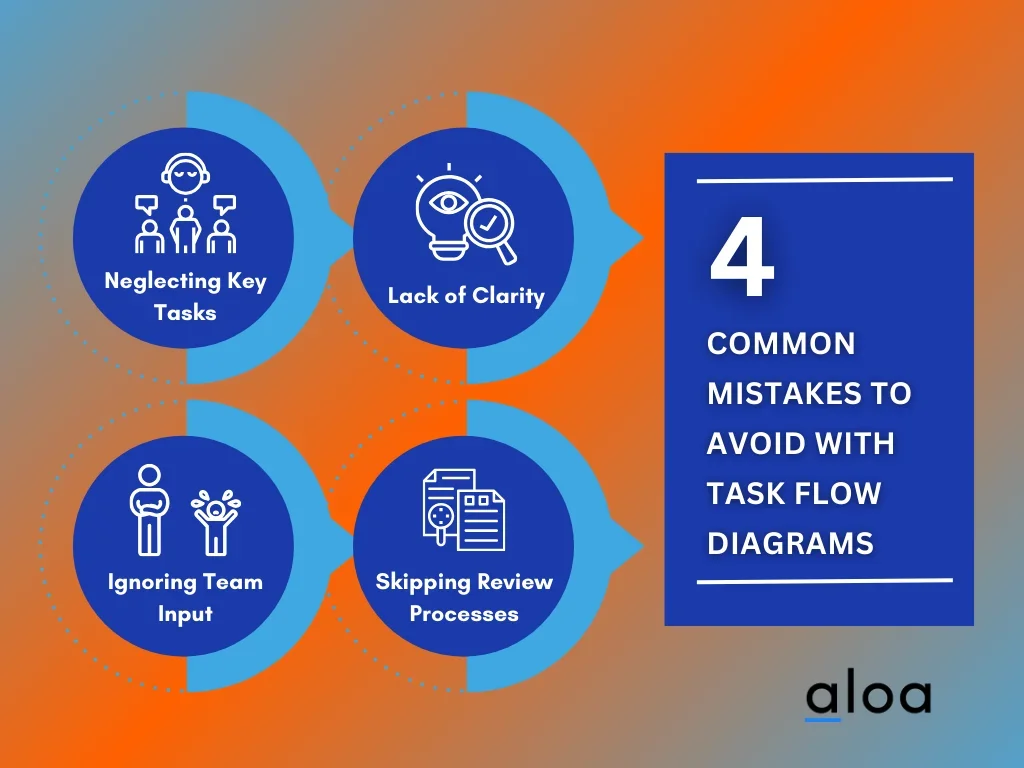
Neglecting Key Tasks
Overstuffing a task flow diagram can lead to further complications and delays in a project. The main target of having a task flow diagram is to ensure that the direction of all assignments is simple yet consistent.
Keep the flowchart focused on the key tasks that make up the entirety of the overall project. Losing track of which assignments are considered "key" will only send team members in disarray when it comes to prioritizing their work output.
Lack of Clarity
Both team members and possible stakeholders need to be able to clearly read and understand the flowchart in order to prevent confusion with the project. Each key step should be taken into account in a concise manner to ensure that there will always be a transparent form of progression with each accomplished assignment.
Ignoring Team Input
Projects can undergo sudden changes even with careful scrutiny and care. It's essential to prepare to listen to your team's input to ensure that every possible issue can be addressed in a timely manner while also figuring out ways to improve the efficiency of each task.
Skipping Review Processes
With every task completed on the flowchart, a thorough review process must be made before immediately moving on to the next phase. Managers should keep a checklist on hand to determine if the performance and qualifications were all met before allowing other users to begin operations for the next critical step in the task flow diagram.
Benefits of a Task Flow Diagram
Startups can take full advantage of a task flow diagram by using it as a simple flowchart to base each accomplishment as a target before reaching the final destination. With multiple design options for task flow diagrams, businesses can utilize various charts based on their needs and goals.
Here are other essential benefits to consider when using task flow diagrams:
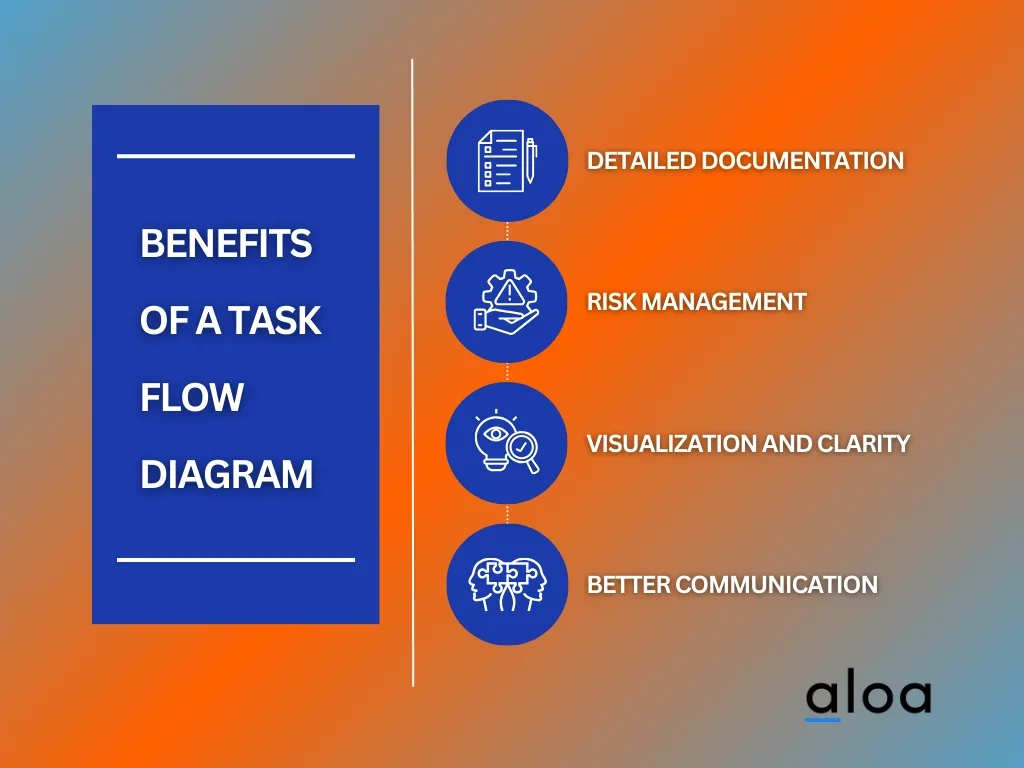
Detailed Documentation
The overall task flow diagram can serve as the official documentation plan when dealing with a project. Stakeholders or clients can use this as a guide to learn about the progress made and the steps left before all tasks are completed. These diagrams can also provide a historical record of how the project was planned and executed, which can be used for auditing and any other future planning purposes.
Risk Management
Planning out all essential steps in order to complete a project can lead to the discovery of any potential bottlenecks, issues, and even delays. It's vital that every task flow diagram heavily considers risk management as part of its overall structure to prevent minor problems from turning into critical issues later on.
Visualization and Clarity
Having a clear visual representation of each key step and the effects that it has on the overall project can help paint a better understanding of which component requires more attention than others. Better clarity and visualization also enable team members to have a clearer understanding of the project's health.
Better Communication
Task flow diagrams enable team members to better communicate with one another when fulfilling assignments that have specific dependencies to achieve before completion. This apparent need for communication allows for better ownership and responsibility of each particular task. It also prevents the mishandling of schedules for other tasks.
Key Takeaway
A task flow diagram is an excellent way for businesses to properly formulate an easy-to-follow flowchart on every key component of a project. Each step in the diagram clearly dictates the dependencies, decision points, and milestone goals in order to effectively move on to the next course of action.
If you're ready to start planning out the most optimal task flow diagram for your company, contact us at [email protected] for more information.

